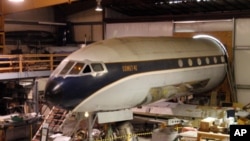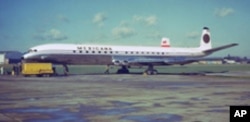The jet age of passenger travel began when the de Havilland Comet airliner took flight in Britain in 1949.
Now, the only complete de Havilland Comet to survive in the Western Hemisphere is being restored in Everett, Washington.
Taking flight
It was back in 1950 that newsreels first depicted commercial flight much as passengers experience air travel today. Travelers soared high above the clouds instead of bouncing along in a noisier, slower, propeller-driven plane at the mercy of the weather.
The British-built de Havilland Comet was the first jet airliner in passenger service. Prior to that, only the military had jets. Even today, the plane is recognizably different. The four turbojet engines are embedded directly into the wings. They're not slung below the wing or attached to the tail as is common now.
Seattle's Museum of Flight acquired one of the few surviving examples in 1994. Retired electrical engineer Bob Hood felt an instant attraction and has since led the mostly volunteer restoration crew.
"People don't realize how much air travel has changed," says Hood. "The Comet made worldwide travel possible and practical because the piston airliners were slow and high maintenance and they just didn't have the comfort for passengers that the jets did."
Comet troubles
The Comet entered scheduled service in 1952 but a flaw in the initial design led to two mid-air explosions in 1954. Hood says the entire fleet was grounded, but the groundbreaking continued.
"Even the accident investigation was full of innovation. It was the first time they had immersed a hull in water and pressure-cycled it until it broke," Hood says. "They were able to look at and analyze the break."
The design flaw was fixed but the disasters damaged the Comet's reputation and gave rivals a chance to catch up. Soon the American-made Douglas DC-8 and Boeing 707 would overtake the British forerunner.
Ironically, the Comet museum piece is being lovingly restored mostly by retired workers from rival plane maker Boeing - on Boeing's home turf of Washington State, where the Seattle Museum of Flight is located.
The Comet's interior might be completed by the end of 2010 and then full restoration is in sight. Hood says this restoration is taking so long because many corroded parts have to be copied and retooled by hand.
Hood points to the gallery as an example. "The only thing here that is really original is the stainless steel counter surfaces. Almost everything else has been remade, some of it from scratch. We had the corroded and torn up originals that we made copies of."
Back in the public eye
The Comet that is currently being restored was the first jet flown by Mexicana Airlines. The 81-passenger plane is now back in good enough shape so that aviation buffs can tour it at the restoration center in Everett, Washington. Eventually it will move into a new gallery at the Museum of Flight in nearby Seattle. Museum spokesman Ted Huetter says the plan is to display it alongside its milestone successors.
"We've got the original Boeing 747. We've got the original 727 and 737," says Huetter. "We've also have a Lockheed Super Constellation that's going to be moved to the airpark in just a couple of weeks. All of them very, very significant and rare airplanes."
According to Huetter, the museum's long range plan is to put all of the aircraft under cover to protect them from Seattle's long, damp winters. It's a big undertaking. Huetter says there's no official date yet for completion of the Comet restoration or for the opening of the new commercial aviation gallery at the flight museum.













